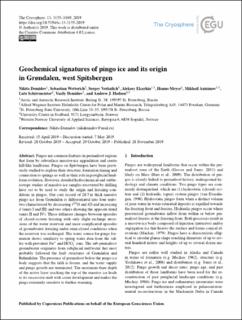| dc.contributor.author | Demidov, Nikita | |
| dc.contributor.author | Wetterich, Sebastian | |
| dc.contributor.author | Verkulich, Sergey | |
| dc.contributor.author | Ekaykin, Alexey | |
| dc.contributor.author | Meyer, Hanno | |
| dc.contributor.author | Anisimov, Mikhail | |
| dc.contributor.author | Schirrmeister, Lutz | |
| dc.contributor.author | Demidov, Vasily | |
| dc.contributor.author | Hodson, Andrew | |
| dc.coverage.spatial | Svalbard | en_US |
| dc.date.accessioned | 2020-03-16T07:40:28Z | |
| dc.date.available | 2020-03-16T07:40:28Z | |
| dc.date.created | 2020-02-05T17:15:58Z | |
| dc.date.issued | 2019 | |
| dc.identifier.citation | Demidov, N., Wetterich, S., Verkulich, S., Ekaykin, A., Meyer, H., Anisimov, M., … Hodson, A. J. (2019). Geochemical signatures of pingo ice and its origin in Grøndalen, west Spitsbergen. The Cryosphere, 13(11), 3155-3169 | en_US |
| dc.identifier.issn | 1994-0416 | |
| dc.identifier.uri | https://hdl.handle.net/11250/2646851 | |
| dc.description.abstract | Pingos are common features in permafrost regions that form by subsurface massive-ice aggradation and create hill-like landforms. Pingos on Spitsbergen have been previously studied to explore their structure, formation timing and connection to springs as well as their role in postglacial landform evolution. However, detailed hydrochemical and stableisotope studies of massive-ice samples recovered by drilling have yet to be used to study the origin and freezing conditions in pingos. Our core record of 20.7 m thick massive pingo ice from Grøndalen is differentiated into four units: two characterised by decreasing δ 18O and δD and increasing d (units I and III) and two others showing the opposite trend (units II and IV). These delineate changes between episodes of closed-system freezing with only slight recharge inversions of the water reservoir and more complicated episodes of groundwater freezing under semi-closed conditions when the reservoir was recharged. The water source for pingo formation shows similarity to spring water data from the valley with prevalent Na+ and HCO− 3 ions. The sub-permafrost groundwater originates from subglacial meltwater that most probably followed the fault structures of Grøndalen and Bøhmdalen. The presence of permafrost below the pingo ice body suggests that the talik is frozen, and the water supply and pingo growth are terminated. The maximum thaw depth of the active layer reaching the top of the massive ice leads to its successive melt with crater development and makes the pingo extremely sensitive to further warming. | en_US |
| dc.language.iso | eng | en_US |
| dc.publisher | Copernicus Publications | en_US |
| dc.rights | Navngivelse 4.0 Internasjonal | * |
| dc.rights.uri | http://creativecommons.org/licenses/by/4.0/deed.no | * |
| dc.title | Geochemical signatures of pingo ice and its origin in Grøndalen, West Spitsbergen | en_US |
| dc.type | Peer reviewed | en_US |
| dc.type | Journal article | en_US |
| dc.description.version | publishedVersion | en_US |
| dc.rights.holder | © Author(s) 2019. | en_US |
| dc.subject.nsi | VDP::Matematikk og Naturvitenskap: 400::Geofag: 450::Kvartærgeologi, glasiologi: 465 | en_US |
| dc.source.pagenumber | 3155-3169 | en_US |
| dc.source.volume | 13 | en_US |
| dc.source.journal | The Cryosphere | en_US |
| dc.source.issue | 11 | en_US |
| dc.identifier.doi | 10.5194/tc-13-3155-2019 | |
| dc.identifier.cristin | 1791334 | |
| dc.relation.project | Andre: JPI-Climate Topic 2 - 71126 | en_US |
| dc.relation.project | Andre: Russian Science Foundation - 19-77-10066 | en_US |
| dc.relation.project | Andre: Deutsche Forschungsgemeinschaft - WE4390/7-1 | en_US |
| cristin.ispublished | true | |
| cristin.fulltext | original | |
| cristin.qualitycode | 2 | |

